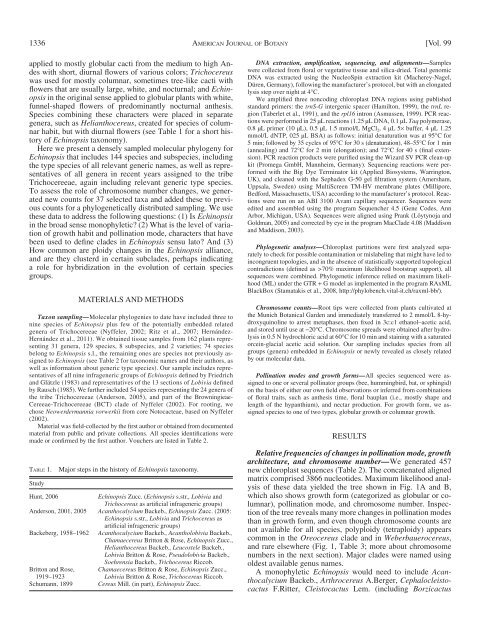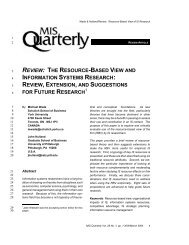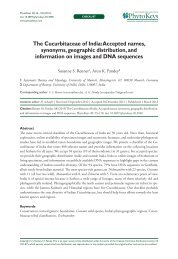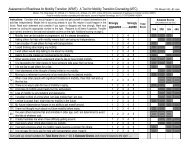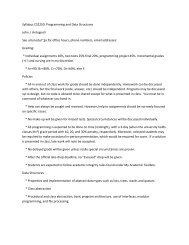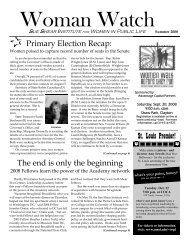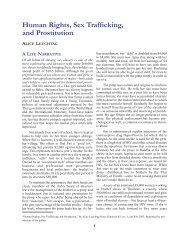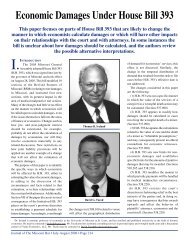molecular phylogenetics of echinopsis (cactaceae)
molecular phylogenetics of echinopsis (cactaceae)
molecular phylogenetics of echinopsis (cactaceae)
You also want an ePaper? Increase the reach of your titles
YUMPU automatically turns print PDFs into web optimized ePapers that Google loves.
1336 AMERICAN JOURNAL OF BOTANY [Vol. 99<br />
applied to mostly globular cacti from the medium to high Andes<br />
with short, diurnal fl owers <strong>of</strong> various colors; Trichocereus<br />
was used for mostly columnar, sometimes tree-like cacti with<br />
fl owers that are usually large, white, and nocturnal; and Echinopsis<br />
in the original sense applied to globular plants with white,<br />
funnel-shaped fl owers <strong>of</strong> predominantly nocturnal anthesis.<br />
Species combining these characters were placed in separate<br />
genera, such as Helianthocereus , created for species <strong>of</strong> columnar<br />
habit, but with diurnal fl owers (see Table 1 for a short history<br />
<strong>of</strong> Echinopsis taxonomy).<br />
Here we present a densely sampled <strong>molecular</strong> phylogeny for<br />
Echinopsis that includes 144 species and subspecies, including<br />
the type species <strong>of</strong> all relevant generic names, as well as representatives<br />
<strong>of</strong> all genera in recent years assigned to the tribe<br />
Trichocereeae, again including relevant generic type species.<br />
To assess the role <strong>of</strong> chromosome number changes, we generated<br />
new counts for 37 selected taxa and added these to previous<br />
counts for a phylogenetically distributed sampling. We use<br />
these data to address the following questions: (1) Is Echinopsis<br />
in the broad sense monophyletic? (2) What is the level <strong>of</strong> variation<br />
<strong>of</strong> growth habit and pollination mode, characters that have<br />
been used to defi ne clades in Echinopsis sensu lato? And (3)<br />
How common are ploidy changes in the Echinopsis alliance,<br />
and are they clusterd in certain subclades, perhaps indicating<br />
a role for hybridization in the evolution <strong>of</strong> certain species<br />
groups.<br />
MATERIALS AND METHODS<br />
Taxon sampling — Molecular phylogenies to date have included three to<br />
nine species <strong>of</strong> Echinopsis plus few <strong>of</strong> the potentially embedded related<br />
genera <strong>of</strong> Trichocereeae ( Nyffeler, 2002 ; Ritz et al., 2007 ; Hernández-<br />
Hernández et al., 2011 ). We obtained tissue samples from 162 plants representing<br />
31 genera, 129 species, 8 subspecies, and 2 varieties; 74 species<br />
belong to Echinopsis s.l., the remaining ones are species not previously assigned<br />
to Echinopsis (see Table 2 for taxonomic names and their authors, as<br />
well as information about generic type species). Our sample includes representatives<br />
<strong>of</strong> all nine infrageneric groups <strong>of</strong> Echinopsis defi ned by Friedrich<br />
and Glätzle (1983) and representatives <strong>of</strong> the 13 sections <strong>of</strong> Lobivia defi ned<br />
by Rausch (1985) . We further included 54 species representing the 24 genera <strong>of</strong><br />
the tribe Trichocereeae ( Anderson, 2005 ), and part <strong>of</strong> the Browningieae-<br />
Cereeae-Trichocereeae (BCT) clade <strong>of</strong> Nyffeler (2002) . For rooting, we<br />
chose Neowerdermannia vorwerkii from core Notocacteae, based on Nyffeler<br />
(2002) .<br />
Material was fi eld-collected by the fi rst author or obtained from documented<br />
material from public and private collections. All species identifi cations were<br />
made or confi rmed by the fi rst author. Vouchers are listed in Table 2 .<br />
T ABLE 1. Major steps in the history <strong>of</strong> Echinopsis taxonomy.<br />
Study<br />
Hunt, 2006 Echinopsis Zucc. ( Echinopsis s.str., Lobivia and<br />
Trichocereus as artifi cial infrageneric groups)<br />
Anderson, 2001 , 2005 Acanthocalycium Backeb., Echinopsis Zucc. (2005:<br />
Echinopsis s.str., Lobivia and Trichocereus as<br />
artifi cial infrageneric groups)<br />
Backeberg, 1958–1962 Acanthocalycium Backeb., Acantholobivia Backeb.,<br />
Chamaecereus Britton & Rose, Echinopsis Zucc.,<br />
Helianthocereus Backeb., Leucostele Backeb.,<br />
Lobivia Britton & Rose, Pseudolobivia Backeb.,<br />
Soehrensia Backeb., Trichocereus Riccob.<br />
Britton and Rose, Chamaecereus Britton & Rose, Echinopsis Zucc.,<br />
1919–1923<br />
Lobivia Britton & Rose, Trichocereus Riccob.<br />
Schumann, 1899 Cereus Mill. (in part), Echinopsis Zucc.<br />
DNA extraction, amplifi cation, sequencing, and alignments — Samples<br />
were collected from fl oral or vegetative tissue and silica-dried. Total genomic<br />
DNA was extracted using the NucleoSpin extraction kit (Macherey-Nagel,<br />
Düren, Germany), following the manufacturer’s protocol, but with an elongated<br />
lysis step over night at 4 ° C.<br />
We amplifi ed three noncoding chloroplast DNA regions using published<br />
standard primers: the trnS-G intergenic spacer ( Hamilton, 1999 ), the trnL region<br />
( Taberlet et al., 1991 ), and the rpl16 intron ( Asmussen, 1999 ). PCR reactions<br />
were performed in 25 µL reactions (1.25 µL DNA, 0.1 µL Taq polymerase,<br />
0.8 µL primer (10 µL), 0.5 µL 1.5 mmol/L MgCl 2 , 4 µL 5 × buffer, 4 µL 1.25<br />
mmol/L dNTP, 025 µL BSA) as follows: initial denaturation was at 95 ° C for<br />
5 min; followed by 35 cycles <strong>of</strong> 95 ° C for 30 s (denaturation), 48–55 ° C for 1 min<br />
(annealing) and 72 ° C for 2 min (elongation); and 72 ° C for 40 s (fi nal extension).<br />
PCR reaction products were purifi ed using the Wizard SV PCR clean-up<br />
kit (Promega GmbH, Mannheim, Germany). Sequencing reactions were performed<br />
with the Big Dye Terminator kit (Applied Biosystems, Warrington,<br />
UK), and cleaned with the Sephadex G-50 gel fi ltration system (Amersham,<br />
Uppsala, Sweden) using MultiScreen TM-HV membrane plates (Millipore,<br />
Bedford, Massachusetts, USA) according to the manufacturer’s protocol. Reactions<br />
were run on an ABI 3100 Avant capillary sequencer. Sequences were<br />
edited and assembled using the program Sequencher 4.5 (Gene Codes, Ann<br />
Arbor, Michigan, USA). Sequences were aligned using Prank ( Löytynoja and<br />
Goldman, 2005 ) and corrected by eye in the program MacClade 4.08 ( Maddison<br />
and Maddison, 2003 ).<br />
Phylogenetic analyses — Chloroplast partitions were fi rst analyzed separately<br />
to check for possible contamination or mislabeling that might have led to<br />
incongruent topologies, and in the absence <strong>of</strong> statistically supported topological<br />
contradictions (defi ned as > 70% maximum likelihood bootstrap support), all<br />
sequences were combined. Phylogenetic inference relied on maximum likelihood<br />
(ML) under the GTR + G model as implemented in the program RAxML<br />
BlackBox ( Stamatakis et al., 2008 , http://phylobench.vital-it.ch/raxml-bb/).<br />
Chromosome counts — Root tips were collected from plants cultivated at<br />
the Munich Botanical Garden and immediately transferred to 2 mmol/L 8-hydroxyquinoline<br />
to arrest metaphases, then fi xed in 3c:c1 ethanol–acetic acid,<br />
and stored until use at −20 ° C. Chromosome spreads were obtained after hydrolysis<br />
in 0.5 N hydrochloric acid at 60 ° C for 10 min and staining with a saturated<br />
orcein-glacial acetic acid solution. Our sampling includes species from all<br />
groups (genera) embedded in Echinopsis or newly revealed as closely related<br />
by our <strong>molecular</strong> data.<br />
Pollination modes and growth forms — All species sequenced were assigned<br />
to one or several pollinator groups (bee, hummingbird, bat, or sphingid)<br />
on the basis <strong>of</strong> either our own fi eld observations or inferred from combinations<br />
<strong>of</strong> fl oral traits, such as anthesis time, fl oral bauplan (i.e., mostly shape and<br />
length <strong>of</strong> the hypanthium), and nectar production. For growth form, we assigned<br />
species to one <strong>of</strong> two types, globular growth or columnar growth.<br />
RESULTS<br />
Relative frequencies <strong>of</strong> changes in pollination mode, growth<br />
architecture, and chromosome number — We generated 457<br />
new chloroplast sequences ( Table 2 ). The concatenated aligned<br />
matrix comprised 3866 nucleotides. Maximum likelihood analysis<br />
<strong>of</strong> these data yielded the tree shown in Fig. 1A and B ,<br />
which also shows growth form (categorized as globular or columnar),<br />
pollination mode, and chromosome number. Inspection<br />
<strong>of</strong> the tree reveals many more changes in pollination modes<br />
than in growth form, and even though chromosome counts are<br />
not available for all species, polyploidy (tetraploidy) appears<br />
common in the Oreocereus clade and in Weberbauerocereus ,<br />
and rare elsewhere ( Fig. 1 , Table 3 ; more about chromosome<br />
numbers in the next section). Major clades were named using<br />
oldest available genus names.<br />
A monophyletic Echinopsis would need to include Acanthocalycium<br />
Backeb., Arthrocereus A.Berger, Cephalocleistocactus<br />
F.Ritter, Cleistocactus Lem. (including Borzicactus


